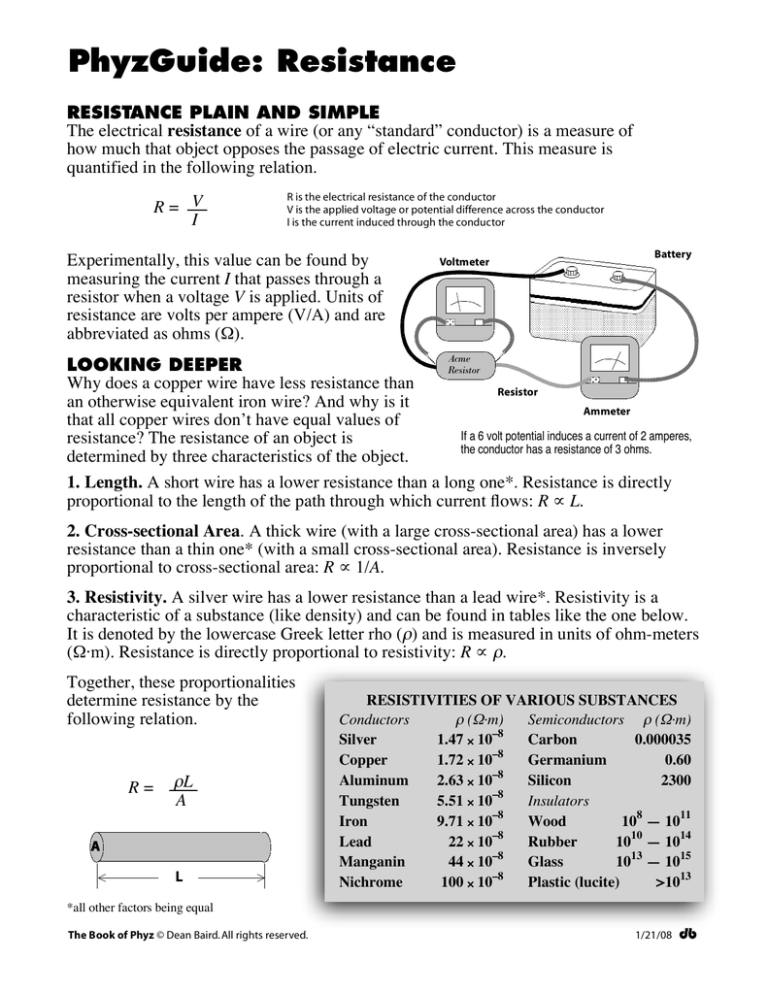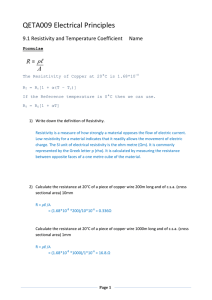
PhyzGuide: Resistance
RESISTANCE PLAIN AND SIMPLE
The electrical resistance of a wire (or any “standard” conductor) is a measure of
how much that object opposes the passage of electric current. This measure is
quantified in the following relation.
R= V
I
R is the electrical resistance of the conductor
V is the applied voltage or potential difference across the conductor
I is the current induced through the conductor
Experimentally, this value can be found by
measuring the current I that passes through a
resistor when a voltage V is applied. Units of
resistance are volts per ampere (V/A) and are
abbreviated as ohms (Ω).
Voltmeter
Battery
Acme
LOOKING DEEPER
Resistor
Why does a copper wire have less resistance than
Resistor
an otherwise equivalent iron wire? And why is it
Ammeter
that all copper wires don’t have equal values of
If a 6 volt potential induces a current of 2 amperes,
resistance? The resistance of an object is
the conductor has a resistance of 3 ohms.
determined by three characteristics of the object.
1. Length. A short wire has a lower resistance than a long one*. Resistance is directly
proportional to the length of the path through which current flows: R ∝ L.
2. Cross-sectional Area. A thick wire (with a large cross-sectional area) has a lower
resistance than a thin one* (with a small cross-sectional area). Resistance is inversely
proportional to cross-sectional area: R ∝ 1/A.
3. Resistivity. A silver wire has a lower resistance than a lead wire*. Resistivity is a
characteristic of a substance (like density) and can be found in tables like the one below.
It is denoted by the lowercase Greek letter rho (ρ) and is measured in units of ohm-meters
(Ω·m). Resistance is directly proportional to resistivity: R ∝ ρ.
Together, these proportionalities
determine resistance by the
following relation.
R=
ρL
A
A
L
RESISTIVITIES OF VARIOUS SUBSTANCES
Conductors
ρ (Ω·m)
Semiconductors ρ (Ω·m)
–8
Silver
1.47 × 10
Carbon
0.000035
–8
Copper
1.72 × 10
Germanium
0.60
–8
Aluminum
2.63 × 10
Silicon
2300
–8
Tungsten
5.51 × 10
Insulators
–8
Iron
9.71 × 10
Wood
108 — 1011
Lead
22 × 10–8
Rubber
1010 — 1014
Manganin
44 × 10–8
Glass
1013 — 1015
Nichrome
100 × 10–8
Plastic (lucite)
>1013
*all other factors being equal
The Book of Phyz © Dean Baird. All rights reserved.
1/21/08
db
BUT WAIT! THERE’S MORE...
The resistance of an object depends on its length, cross-sectional area, and the resistivity
of the substance from which it was made. But a funny thing happens when the
temperature changes. If a metal object is heated, its resistance goes up. If an object made
of semiconducting material is heated, its resistance goes down. (Technically, it is the
resistivity of the substances that increases or decreases—we will deal only with the
resulting change in resistance.)
To quantify this odd behavior, we use the following relation. If an object has a resistance
R0 at a given temperature, its resistance R at a different temperature is
R = R0(1 + α∆T)
R is the resistance at the new temperature
R0 is the resistance at the old temperature
α is the temperature coefficient of resistivity
T is the change in temperature
The temperature coefficient of resistivity is a characteristic of a substance (as is
resistivity itself). It is denoted by the lowercase Greek letter alpha (α) and has units of
1/°C (or, equivalently, 1/K). Specific values of the temperature coefficient of resistivity
can be found in tables like the one below.
WHY?
Why does the resistivity of a metal vary with temperature? Why does a metal resist the
flow of charge at all? When electrons travel in a wire, they collide with the relatively
heavy metal ions (nuclei and bound electrons). These collisions cause the ions to jiggle
more. Faster jiggling means higher temperature. As other electrons try to move through
the wire, they are impeded to a greater extent by these faster-jiggling ions. There are
therefore more collisions and a further increase in temperature. Semiconductors conduct
current by a different mechanism; one that does not involve the free electrons present in
metals. For further details, you will have to study
semiconductors: the materials at the heart of solid
TEMPERATURE
state electronics (diodes, transistors, etc.).
COEFFICIENTS OF
HOW WILL IT MAKE ME RICH?
The dependence of resistance on temperature is used
to measure temperatures when ordinary “thermal
expansion”-based devices cannot be used. The
thermister is such a device.
DO NOT OPERATE IN DIRECT
SUNLIGHT
The warning above appears on some portable tape
players and radios. These devices contain many
silicon-based electrical components in their circuitry.
Look up the temperature coefficient of resistivity for
silicon and ponder the significance of the warning:
what would happen if the device was operated in
direct sunlight?
The Book of Phyz © Dean Baird. All rights reserved.
RESISTIVITY FOR
VARIOUS SUBSTANCES
Conductors
α (1/°C)
Manganin
0.0000
Nichrome
0.0004
Platinum
0.0036
Silver
0.0038
Aluminum
0.0039
Copper
0.0039
Lead
0.0043
Tungsten
0.0045
Iron
0.0065
Semiconductors
Carbon
Germanium
Silicon
α (1/°C)
–0.0005
–0.05
–0.07
1/21/08
db






